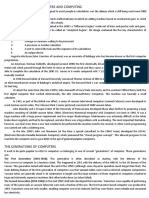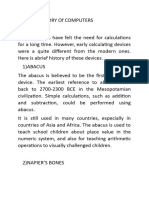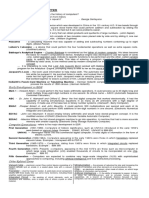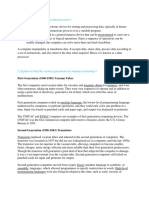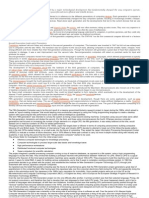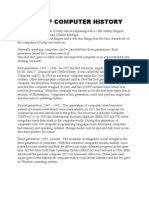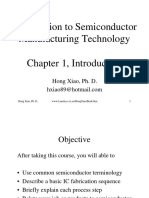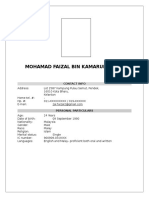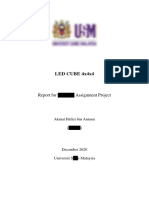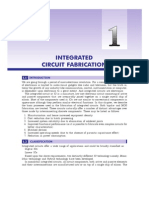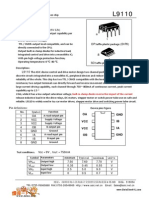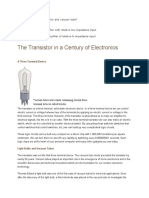Department of Computer Science
Faculty of Science
University of Abuja
CSC 200: Introduction to Computers
Lecture 5
Title: History of Computers
Description:
Milestones in computer history are numerous, especially since the advent of digital computers
around the mid-twentieth century. History of computing has become a semester-long university
course and therefore, it’s coverage in this lecture will be far from exhaustive. This lecture will
introduce students to the basic history and evolution of computers covering the pre-mechanical,
mechanical and digital era.
Objectives:
Students will learn
1. different era of the history of computing
2. generations of computing hardware and software
3. prominent inventors of computing hardware and software
4. computing hardware invented in pre-mechanical, mechanical and digital era
History of Computers
The literature is replete with many different written versions of the history of computing starting
from the ancient era. However, a deeper examination revealed some commonalities and in this
lecture, the focus will be on those common view points. The history will cover pre-mechanical
era (ancient era), mechanical era, electro-mechanical era and modern era.
Ancient Era
Devices have been used to aid computation for thousands of years, mostly using one-to-one
correspondence with fingers. The earliest counting device was probably a form of tally stick.
Another was the use of counting rods.
The earliest known device used for arithmetic tasks was Abacus, which has beads strung into
wires attached to a frame. What we now call the Roman abacus was used in Babylonia as early
as 2400 BC. Since then, many other forms of reckoning boards or tables have been invented.
Mechanical Era
In 1642 Blaise Pascal (a famous French mathematician) invented an adding machine based on
mechanical gears in which numbers were represented by the cogs on the wheels.
1
In 1690, Leibnitz developed a machine that could perform additions, subtractions, divisions and
square roots. These instructions were hardcoded and could not be altered once written.
In 1822, an Englishman, Charles Babbage invented a machine called “Difference Engine,” that
would perform calculations without human intervention. In 1833, he developed the “Anatytic
Engine” along with his associate Augusta Ada Byron (later Countess of Lovelace) who assisted
with the programming. His design contained the basic units of a modern computer: input, output
and processing units, memory and storage devices. Hence he is regarded as the “father of the
modern day computers.”
Electro-Mechanical Era.
An American, Herman Hollerith, developed (around 1890) the first electrically driven device. It
utilized punched cards and metal rods which passed through the holes to close an electrical
circuit and thus cause a counter to advance. This machine was able to complete the calculation of
the 1890 U.S. census in 6 weeks compared with 7 1/2 years for the 1880 census which was
manually counted.
In 1936 Howard Aiken of Harvard University convinced Thomas Watson of IBM to invest $1
million in the development of an electromechanical version of Babbage's analytical engine. The
Harvard Mark 1 was completed in 1944 and was 8 feet high and 55 feet long.
At about the same time (the late 1930's) John Atanasoff of Iowa State University and his
assistant Clifford Berry built the first digital computer that worked electronically, the ABC
(Atanasoff-Berry Computer). This machine was basically a small calculator.
In 1943, as part of the British war effort, a series of vacuum tube based computers (named
Colossus) were developed to crack German secret codes. The Colossus Mark 2 series consisted
of 2400 vacuum tubes.
John Mauchly and J. Presper Eckert of the University of Pennsylvania developed these ideas
further by proposing a huge machine consisting of 18,000 vacuum tubes. ENIAC (Electronic
Numerical Integrator And Computer) was born in 1946. It was a huge machine with a huge
power requirement and two major disadvantages. Maintenance was extremely difficult as the
tubes broke down regularly and had to be replaced, and also there was a big problem with
overheating. The most important limitation, however, was that every time a new task needed to
be performed the machine must be rewired.
In the late 1940's John von Neumann (at the time a special consultant to the ENIAC team)
developed the EDVAC (Electronic Discrete Variable Automatic Computer) which pioneered the
"stored program concept". This allowed programs to be read into the computer and so gave birth
to the age of general-purpose computers.
2
Modern Era
In the modern era, computers are classified into a number of generations. The classification can
be based on the hardware technology used in building the computer or based on
applications/software used. Note that, the literature did not present consistent generational
periods and therefore those indicated here may be different from several generational periods in
the literature.
First-Generation Computers (1943-1958)
The first generation of computers started with ENIAC described above. This was followed by
IBM UNIVAC (Universal Automatic Computer) designed and built by Mauchly and Eckert in
1951.
The first generation computers used vacuum tubes, which were very large, requiring lot of
energy and slow in input and output processing. They also suffered from heat and maintenance
problems. The vacuum tubes have to be replaced often because of their short life span. See
figures below for the ENIAC machine and vacuum tubes.
ENIAC and Vacuum Tubes
3
Second Generation Computers (1959-1964)
In the mid-1950's Bell Labs developed the transistor. Transistors were capable of performing
many of the same tasks as vacuum tubes but were only a fraction of the size. The first transistor-
based computer was produced in 1959. Transistors were not only smaller, enabling computer
size to be reduced, but they were faster, more reliable and consumed less electricity. See figure
below for sample transistors.
Transistors
The computers were able to perform operations comparatively faster. The storage capacity was
also improved. IBM 650, 700, 305 RAMAC, 1401, and 1620 desktop computers were
manufactured and distributed during this period. It was also during this period, assembly and
symbolic programming languages and high level computer programming languages, such as
FORTRAN (FORmula TRANslation) and COBOL (Common Business Oriented Language) and
BASIC ( Beginner’s All-purpose Symbolic Instruction Code), were launched. Computer
programs written in these English-like high-level programming languages are translated to
machine code using interpreters, compilers or translators.
4
Third-Generation Computers (1965-1970)
This period marked the development of computers based on Integrated Circuits (ICs) instead of
transistors. An integrated circuit or monolithic integrated circuit (also referred to as an IC, a chip,
or a microchip) is a set of electronic circuits on one small plate ("chip") of semiconductor
material, normally silicon. A silicon chip consumes less than one-eighth of an inch square on
which many electronic components like diodes, transistors, and capacitors can be fixed. See
figure below for an illustration of an integrated circuit on a chip. Third generation computers are
smaller, faster and more flexible in terms of input and output than second generation computers.
Third generation computers satisfy the need of a small business and became popular as
minicomputers. IBM 360, PDP 8 and PDP 11 computers are examples for third generation
computers.
Another feature of this period is that
computer software became much more
powerful and flexible and for the first
time more than one program could share
the computer's resources at the same
time (multi-tasking). The majority of
programming languages used today are
often referred to as 3GL's (3rd
generation languages) even though
some of them originated during the 2nd
generation.
Fourth Generation Computers (1971-1989)
The third generation computers have integrated circuits consisting of anywhere from 1 to 500
transistors and were considered small-scale integration (1 to 10 transistors) to medium-scale
integration (10 to 500 transistors). In 1970 large-scale integration was achieved where the
equivalent of thousands of integrated circuits were crammed onto a single silicon chip. This
development again increased computer performance (especially reliability and speed) whilst
reducing computer size and cost. Around this time the first complete general-purpose
microprocessor became available on a single chip (giving birth to microcomputers, also called
personal computers). In 1975 Very Large Scale Integration (VLSI) took the process one step
further. The development started with hundreds of thousands of transistors in the early 1980s,
and continues beyond several billion transistors as of 2009. Examples of fourth generation
computers are IBM PC and Apple II. The fourth generation computers also include
supercomputers such as CRAY series computers. Supercomputers are the best in terms in
processing capacity and cost. These computers can process billions of instructions per second.
They are used for applications which require intensive numerical computations such as stock
analysis, weather forecasting and other similar complex applications. The spread of computer
network was also observed during this period.
5
During this period Fourth Generation Languages (4GL's) have come into existence. Such
languages are a step further removed from the computer hardware in that they use language
much like natural language. Many database languages can be described as 4GL's. They are
generally much easier to learn than are 3GL's. Microsoft developed MS-DOS operating system
for IBM PCs. In 1980, Alan Shugart presents the Winchester hard drive, revolutionizing storage
for PCs. In 1982, Hayes introduced the 300 bits per second smart modem. In 1989, Tim Berners-
Lee invented an Internet-based hypermedia enterprise for information sharing giving birth to
World Wide Web (WWW). In the same year, Intel 486 becomes the world’s first 1,000,000
transistor microprocessor. It crams 1.2 million transistors on a .4 in by .6 in sliver of silicon and
executes 15 million instructions per second, four times as fast as its predecessor the 80386 chip,
which has 275,000 transistors.
Intel 8086 Microprocessor Chip, Intel 80386, Intel 80486, Intel 80486 (exposed die)
Fifth Generation Computers (1990-Present)
Fifth generation computers are further made smarter in terms of processing speed, user
friendliness and connectivity to network. These computers are portable and sophisticated.
Powerful desktops, notebooks, variety of storage mechanism such as optical disks and advanced
software technology such as distributed operating system and artificial intelligence are
6
characteristic of this period. IBM notebooks, Pentium PCs and PARAM 10000 are examples of
fifth generation computers.
In 1992, Microsoft releases Windows 3.1 and within two months sold over 3 million copies. The
Pentium processor, a successor of Intel 486 was produced in 1993. Pentium processor contains
3.1 million transistors and could perform 112 million instructions per second. Microsoft released
Microsoft Office this same year. Other inventions (not exhaustive) are tabulated below.
1994 – Jim Clark and Marc Andreessen found Netscape and launched Netscape Navigator 1.0, a
browser for the World Wide Web.
1996 – U.S. Robotics introduced the PalmPilot, a low-cost, user-friendly personal digital
assistant (PDA).
1997 – Pentium II processor with 7.5 million transistors was introduced by Intel. This processor
incorporates MMX technology, processes video, audio and graphics data more efficiently and
supports applications such as movie editing, gaming and more. In the same year Microsoft
releases Internet Explorer 4.0.
1998 – Apple Computer releases iMac, the next version of Macintosh computer. iMac did not
feature floppy disk drive. Windows 98 was introduced this year, which was an extension to
Windows 95 with improved Internet access, system performance and support for new generation
of hardware and software. Google, a search engine was founded.
2001 – Intel unveils Pentium 4 chip with clock speeds starting at 1.4 GHz and with 42
transistors. Windows XP for desktops and servers was introduced.
2002 – Intel revamped Pentium 4 chip with 0.13 micron processor and Hyper-Threading (HT)
Technology and operating at a speed of 3.06GHz. DVD writes were introduced to replace CD
writers (CD-RW).
2004 - Flat panel LCD monitors were introduced, replacing the bulky CRT monitors as the
popular choice. USB flash drive was also made popular this year as a cost-effective eay to
transport data amd information. Apple Computer introduced the sleek iMac G5. Smart phone
overtakes the PDA as the perosnal mobile device of choice. A smart phone offers the user a cell
phone, full personal information management, a Web browser, e-mail functionality, instant
messaging and ability to listen to music, watch and record video, play games and take pictures.
In 2005, Microsoft releases Xbox 360, a game console with capability to play music, display
photos, and network with computers and other Xbox games.
2006 – Intel introduced Core 2 Duo processor family with 291 million transistors and uses 40
percent less power than Pentium processor. IBM produced the fastest supercomputer called Blue
Gene/L, which can perform 28 trillion calculations in the time it takes to blink an eye or about
0ne-tenth of a second. Sony launches Playstation 3 to include Blu-ray disc players, high
definition capabilities and always-on online connectivity.
7
2007 – Intel introduces Core 2 Quad, a four-core processor made of dual processor servers and
desktop computers. Apple launches iPhone.
References
1. Figures, charts and computer generations – http://www.gujarat-education.gov.in/
2. Computer Generations and Inter Processors - https://en.wikipedia.org/wiki/Intel_80486
3. A short history of computers and computing by Robert Mannell -
http://clas.mq.edu.au/speech/synthesis/history_computers/
4. G. Shelly and M. Vermaat, 2008, Discovering Computers 2009, Course Technology ,
Cengage Learning.
Practice Problems
1. Write a short note on the history of computers. Explain why Charles Babbage is known
as the father of the modern day computers
2. What are the characteristics of first generation computers? Discuss their major
drawbacks.
3. What are the characteristics of second generation computers? Discuss their major
drawbacks.
4. What distinguishes fourth generation computers from third generation computers?
5. What are the full meanings of these acronyms: ENIAC, UNIVAC, EDVAC, PDA,
FORTRAN, COBOL and BASIC?
6. Who were the major inventors in the electro-mechanical era? Write short notes about
their inventions.
7. What distinguishes Pentium 4 from Pentium II chip?
8. What distinguishes smart phones from PDAs? List all the capabilities of a smart phone.
9. Describe the invention of Herman Hollerith.
10. Describe the invention of Atanasoff and Berry.
11. Describe the invention of Mauchly and Eckert.
12. What is the speed capability of Blue Gene/L developed by IBM in 2006?







